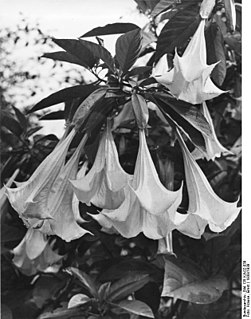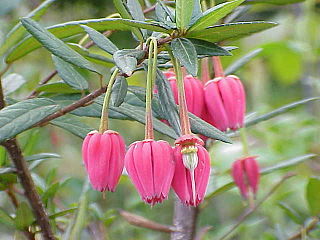Tiliaceae is a botanical name for a family of flowering plants. It is not a part of the APG, APG II and APG III classifications, being sunk in Malvaceae but has an extensive historical record of use.

The lesser white-toothed shrew is a tiny shrew with a widespread distribution in Africa, Asia and Europe. Its preferred habitat is scrub and gardens and it feeds on insects, worms, slugs, snails, newts and small rodents. The closely related Asian lesser white-toothed shrew was once included in this species, but is now considered to be a separate species.

Phyllodes are modified petioles or leaf stems, which are leaf-like in appearance and function. In some plants, these become flattened and widened, while the leaf itself becomes reduced or vanishes altogether. Thus the phyllode comes to serve the purpose of the leaf.

Hyptis is a genus of flowering plant in the Lamiaceae family. These plants, known commonly as bushmints, are widespread in tropical North and South America, as well as parts of West Africa. There are 300 to 400 species, which may be annual or perennial, and small herb to large shrub.

The Cretan shrew is a species of mammal in the family Soricidae. It is endemic and exclusive to the island of Crete, Greece. Its natural habitat is temperate shrubland, and the animal is threatened by habitat loss. It is found in the mountainous highlands of Crete, having been displaced from lower altitudes by the lesser white-toothed shrew.
Sloanea acutiflora is a species of plant in the Elaeocarpaceae family. It is endemic to Suriname.

Sloanea is a genus of flowering plants in the family Elaeocarpaceae, comprising about 150 species.
Sloanea assamica is a species of plant in the Elaeocarpaceae family. It is found in Bhutan, China, India, and Myanmar.
Sloanea gracilis is a species of plant in the Elaeocarpaceae family. It is endemic to Suriname.
Sloanea lepida is a species of plant in the Elaeocarpaceae family. It is endemic to New Caledonia.
Sloanea shankii is a species of plant in the Elaeocarpaceae family. It is endemic to Honduras.
Sloanea tomentosa is a species of plant in the Elaeocarpaceae family. It is found in Bhutan, China, India, Myanmar, Nepal, and Thailand.

Brugmansia suaveolens, Brazil's white angel trumpet, also known as angel's tears and snowy angel’s trumpet, is a species of flowering plant in the nightshade family Solanaceae, native to south eastern Brazil, but thought to be extinct in the wild. Like several other species of Brugmansia, it exists as an introduced species in areas outside its native range. It is a tender shrub or small tree with large semi-evergreen leaves and fragrant white trumpet-shaped flowers.

Sloanea woollsii, commonly known as yellow carabeen, is a large tree species with plank buttresses that is native to northeastern NSW and eastern Queensland, Australia. Its southern distributional limit is near the town of Bulahdelah at Tallowwood Forest Park and O'Sullivans Gap Reserve.

Acacia suaveolens is a shrub species endemic to Australia. It grows to between 0.3 and 3.5 metres high and has smooth purplish-brown or light green bark and has straight or slightly curving blue-green phyllodes The pale yellow to near white globular flower heads generally appear between April and September in its native range. These are followed by flattened, bluish oblong pods which are up to 2 to 5 cm long and 8 to 19 mm wide.
Erythrophleum suaveolens, also known as the ordeal tree, is a species of plants that can be found in Mozambique and Zimbabwe. The species are 20 metres (66 ft) in height, and have a rough and blackish bark. The plants leaves have 2–3 pairs of pinnae, which carry 7–13 leaflets. The leaflets are 5 by 2.5 centimetres, are green coloured and ovate. The flowers have fluffy spikes, and are creamy-yellow coloured. Fruits are hard, the pod of which is flat.

Hasteola suaveolens, known by the common names false Indian plantain and sweet scented Indian plantain, is a perennial forb native to the northeastern and north-central United States. It is found from Massachusetts south to Virginia and North Carolina, and west as far as Minnesota and Minnesota and Missouri.

Plinthocoelium suaveolens is a species of beetles in the family Cerambycidae. It was described by Linnaeus in 1768. It contains the subspecies Plinthocoelium suaveolens suaveolens and Plinthocoelium suaveolens plicatum.

Iris suaveolens is a species in the genus Iris, it is also in the subgenus of Iris. It is a rhizomatous perennial, from Eastern Europe, ranging from the Balkans to Turkey. It has short, sickle shaped or curved, blue-green or greyish green leaves, a slender simple stem, with 1 or 2 fragrant spring blooming, flowers, between yellow and purple, with white or yellow beards. It was once known as Iris mellita, until that was re-classified as a synonym of Iris suaveolens. It is cultivated as an ornamental plant in temperate regions.














